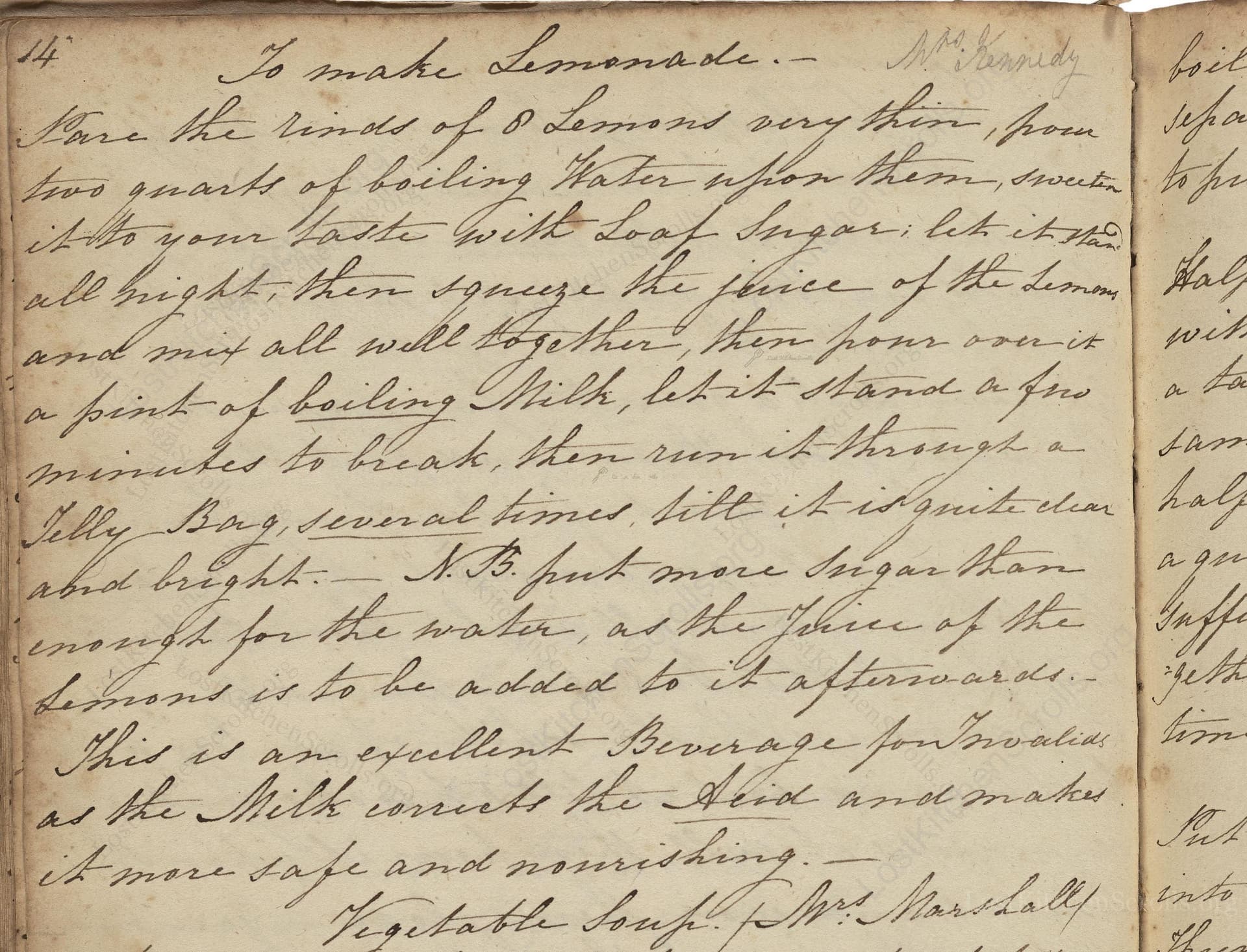To Make Lemonade
From the treasured pages of Receipt book of Jane Staveley
Written by Jane Staveley

To Make Lemonade
"Pare the rinds of 8 Lemons very thin, pour two quarts of boiling Water upon them, sweeten it to your taste with Loaf Sugar; let it stand all night, then squeeze the juice of the lemons and mix all well together, then pour over it a pint of boiling Milk, let it stand a few minutes to break, then run it through a Jelly Bag, several times till it is quite clear and bright. N.B. put more sugar than enough for the water, as the Juice of the Lemons is to be added to it afterwards. This is an excellent Beverage for Invalids as the Milk corrects the Acid and makes it more safe and nourishing."
Note on the Original Text
Early recipes like this one were often written as a single flowing paragraph, with few standardized measurements and an expectation that the cook had experience to guide ingredient quantities and technique. Terms like 'pare the rinds very thin' presume knowledge of proper zesting. Instructions for straining ('run it through a jelly bag') rely on familiar kitchen routines. Spelling was less standardized ('sweeten it to your taste with Loaf Sugar'), and writers sometimes note special tips or warnings, as with the reminder to add extra sugar before the lemon juice. The recipe's gentle voice and attention to health mark it as both practical and caring in a domestic context.

Title
Receipt book of Jane Staveley (1693)
You can also click the book image above to peruse the original tome
Writer
Jane Staveley
Era
1693
Publisher
Unknown
Background
Step into the flavorful annals of the 17th century with Jane Staveley’s delightful culinary collection. Brimming with time-honored recipes and refined instructions, this book offers a sumptuous glimpse into the kitchens of yesteryear—where classic techniques met noble tastes and every dish was a celebration of ingenuity.
Kindly made available by
Folger Shakespeare Library
This recipe hails from late 17th-century England, specifically from the handwritten collection of Jane Staveley, dated 1693 to 1694. At this time, recipes were often shared through domestic manuscripts, passed among households and friends. Lemonade was both a fashionable and medicinal drink, recommended for invalids. The inclusion of milk was thought to 'correct the acid' of the lemons, making the beverage more nourishing and suitable for delicate constitutions. This practice of clarifying drinks with milk was popular in the period, showing the influence of both culinary experimentation and humoral medical theory.

The cook would have used a small, sharp knife to pare the lemon zest and a heavy kitchen knife to halve and juice the lemons, probably with a simple wooden or pewter press. Boiling water and milk would be heated over an open fire in copper or brass kettles. The infusion would rest overnight in glazed earthenware or stoneware bowls. Straining was done with a 'jelly bag'—a linen or flannel sack hung over a bowl, through which liquids could be poured several times for clarity.
Prep Time
20 mins
Cook Time
5 mins
Servings
8
We've done our best to adapt this historical recipe for modern kitchens, but some details may still need refinement. We warmly welcome feedback from fellow cooks and culinary historians — your insights support the entire community!
Ingredients
- 8 lemons
- 8 1/2 cups boiling water
- 1 to 1 1/4 cups caster sugar (or more, to taste)
- 2 cups whole milk
Instructions
- Begin by carefully peeling the thin yellow rind (zest) from 8 lemons, avoiding the bitter white pith.
- Place the zest into a large, heatproof bowl.
- Pour over 8 1/2 cups of freshly boiled water.
- Sweeten generously with caster sugar, starting with 1 cup, adjusting to taste, as the lemon juice will be added later and will require more sweetness.
- Cover and allow to infuse overnight at room temperature.
- The next day, juice all 8 lemons and strain the juice to remove seeds and pulp.
- Add the lemon juice to the infused water.
- Heat 2 cups of whole milk until boiling, then immediately pour it over the lemon mixture.
- Leave for several minutes; the milk will curdle, helping to clarify the lemonade.
- Strain the mixture through cheesecloth or a fine sieve, repeating several times until the liquid is clear and bright.
- Chill and serve.
- This creamy lemonade is refreshing and gentle on the stomach.
Estimated Calories
130 per serving
Cooking Estimates
It takes about 20 minutes to prepare the ingredients and set everything up. Cooking the milk takes about 5 minutes. The lemonade needs to infuse overnight, but that part does not require any work. Each glass of this creamy lemonade has about 130 calories, and the recipe makes 8 servings.
As noted above, we have made our best effort to translate and adapt this historical recipe for modern kitchens, taking into account ingredients nowadays, cooking techniques, measurements, and so on. However, historical recipes often contain assumptions that require interpretation.
We'd love for anyone to help improve these adaptations. Community contributions are highly welcome. If you have suggestions, corrections, or cooking tips based on your experience with this recipe, please share them below.
Join the Discussion
Rate This Recipe
Dietary Preference
Occasions

Den Bockfisch In Einer Fleisch Suppen Zu Kochen
This recipe hails from a German manuscript cookbook compiled in 1696, a time whe...

Die Grieß Nudlen Zumachen
This recipe comes from a rather mysterious manuscript cookbook, penned anonymous...

Ein Boudain
This recipe comes from an anonymous German-language manuscript cookbook from 169...

Ein Gesaltzen Citroni
This recipe, dating from 1696, comes from an extensive anonymous German cookbook...
Browse our complete collection of time-honored recipes



